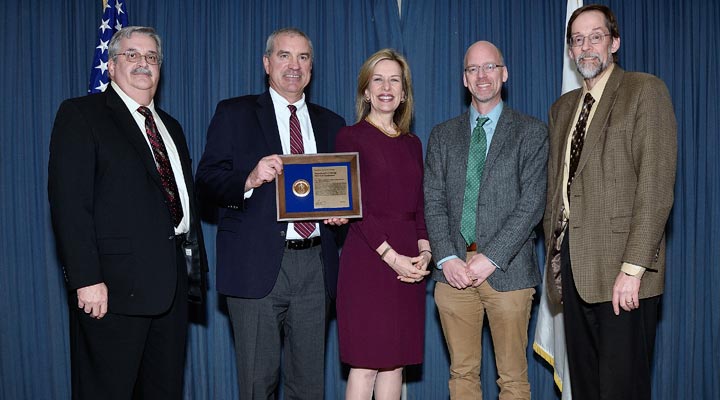Department of Energy Awards Recognize National Synchrotron Light Source II Project and Brookhaven Site Office Leadership
Frank Crescenzo and John Hill accepted the Secretary's Award of Excellence on behalf of the NSLS-II team
April 12, 2016
 enlarge
enlarge
Pictured from left to right: Dr. Phil Kraushaar, NSLS-II Program Manager, BES/SC; Mr. Frank Crescenzo, Federal Project Director; Elizabeth Sherwood-Randall, Deputy Secretary of Energy; Dr. John Hill, NSLS-II Director, BNL; and Dr. Erik Johnson, (former) NSLS-II Deputy Director
At the annual Department of Energy (DOE) Project Management workshop in Arlington, Virginia on March 23, Deputy Secretary of Energy Elizabeth Sherwood-Randall presented the Secretary’s Award of Excellence to the National Synchrotron Light Source II (NSLS-II).
This is the highest honor awarded annually for a project in the DOE complex. NSLS-II was recognized for being completed ahead of schedule, under budget, and with an expanded scope.
At the same event, DOE-Brookhaven Site Office Manager (BHSO) Frank Crescenzo was named the Federal Project Director of the Year for his leadership of and dedication to the NSLS-II project.
“This is a tremendous honor for the Laboratory, for Frank, and for the entire DOE/Laboratory team that poured its heart and soul into this project over the past decade-plus,” said Doon Gibbs, Director of Brookhaven National Laboratory. “I thank and congratulate everyone associated with NSLS-II—both on the project and across the Laboratory—as well as our BHSO and Office of Science partners, for their remarkable, sustained efforts in making NSLS-II the enormous success it is.”
NSLS-II is a DOE Office of Science User Facility that produces extremely bright beams of x-rays used for research in energy science, physics, chemistry, biology, and materials science.
Brookhaven National Laboratory is supported by the Office of Science of the U.S. Department of Energy. The Office of Science is the single largest supporter of basic research in the physical sciences in the United States, and is working to address some of the most pressing challenges of our time. For more information, please visit science.energy.gov.
2016-6305 | INT/EXT | Newsroom









